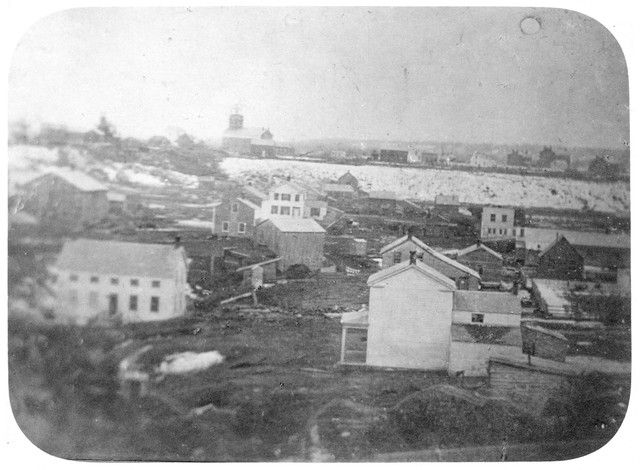Imagining the Landing, 1850
Introduction
Text-to-speech Audio
Images
View of Kellogg Boulevard from Uppertown (1851)

Backstory and Context
Text-to-speech Audio
THE SIGHTS
At the river, instead of a Caribou Coffee and a park, steamboats disgorging passengers at muddy levee, except in the winter when the river froze St. Paul shut.
On the slope, instead of the Science Museum, St. Paul’s first brewery, owned and operated by a German immigrant named Anton Yoerg. A barrel factory, a saddlery and stable. A sawmill running overtime to produce the lumber newcomers needed to put up more houses, shops, and factories. Instead of condos, simple log homes, many of them built by Jim Thompson, a formerly enslaved man who was a prominent citizen of early St. Paul. Instead of paved streets, narrow crosswise dirt roads that alternated between wet and deeply muddy and so dry and rutted they once jostled a casket out of a moving wagon during a funeral procession.
Instead of West 7th Street, a short road that was supposed to reach the US military base at Fort Snelling, but didn't, where one might patronize a hotel notable for lice or a handful of small businesses, and catch sight of the occasional bear.
THE SOUNDS AND SMELLS
People speaking combinations of English, Dakota, French, Ho Chunk, German, Ojibwe, and other Native American languages. The strike of hammers on nails. The buzz of the mill saw. The chuff of steamboat engines. The shriek of wooden wheels and axles on fur trade carts. The distant roar of the falls upriver. A soldier playing Reveille at Fort Snelling.
The stink of tanning leather. The yeast of brewing beer. The scent of newly-lumbered wood. Horse manure and lots of it. During a later soap shortage, the smell of unwashed humans. The occasional bear.
Sources
Millett, Larry. Lost Twin Cities (MNHS Press, 1992).
Impressions of Minnesota in 1849. Minnesota History Magazine. 5:4, December 1923. 286 - 290.
www.mnhs.org
